New S.I.C. Bullet 17’4″ SUP Racing Board
Here is the latest SUP racing board from S.I.C., the new 17’4″ Bullet. This is what the S.I.C. team rode in the 2010 Molokai to Oahu race. Check out the video below where Mark Raaphorst tells us more about the Bullet 17’4″.

(click thumbnail to launch video)
Here are some more info about the Bullet 17’4″ from S.I.C.:
From a designer’s (Mark Raaphorst) point of view:
“The Bullet” by SICAfter the success of our 3 F-Series boards, we were not about to store our shaping tools and give the R & D department a break. We know the F16 is about the fastest in good Maliko run, straight downwind conditions. But, what about the Ka’iwi Channel and the rest of the world. Not all crossings or downwinders have our luxuries. The Ka’iwi is often blowing only 14 to 16 knots and the wind is slightly off to your side.
In the 2009 Ka’iwi Race, Ekolu Kalama, riding a SIC prototype, proved that a straighter rockered, longer board has a better glide in less than ideal conditions.
Just before the 2010 Olukai Race, team rider Livio Menelau requested a similar board. A 17′, lower rockered nose, more elongated and gradual bottom curves. He wanted it even narrower than the F16 v2 (27″) and so we made his 26 ½”. In that race he managed to hold off some big gun watermen like Ching, Kalama, and Napoleon. He got First Place and a new winning model was born. The Bullet.
The Hull:
The front third of the board is flat. In the mid section it moves to a subtle single concave. This configuration really helps with board stability. The single concave will also keep the board speed up longer after you catch a swell. The tail section has a slight Panel V for good release and maneuverability.
The Rocker:
The nose lift is a good 5″ less than the F16. The Bullet is real at ease going across the grain in side swell direction. When straight downwind in heavy seas, it might take some stepping back and old school longboard surfing skills to prevent it from sticking the bow into the next trough. Yet the pay off and reward are the long glides afterwards. Ultimately the winner of a long distance race is not the one who has the fastest top speed but the rider that maintains the highest average speed will be the first across the finish line.
The Deck:
The bow section still has our pronounced V to expel water in case you do poke into an upcoming swell. The section of the deck where you stand has become more of a cockpit. Right after the rudder tiller the deck is really flared up to give you a comfortable footrest and a sense of stability when you are balancing side to side. Towards the rear this contoured deck flattens out, so the water does not accumulate and puddle. All boards come standard with 3 leash plugs. The front 2 can be used to carry the board with your paddle (see photo).
The Steering:
All boards come standard with a dual plumbed steering configuration. Telescopic foot pedals upon requests (added cost is $150)
The Rails:
Full volume rails are still the concept. It keeps the water off the deck. It carries big riders with ease. On the bottom, the under tuck in the front is soft going to hard edges in the planing section of the board.
The Pad:
We have a lighter weight 2 mm EVA pad. It is still integrated (flush) on the deck. It is vacuum bagged on with Epoxy. Not glued on with contact cement. The ‘crocodile skin’ has a slight texture. It is grippy enough for full traction but not too rough as to where you cannot easily walk back and forward.
The Construction:
We switched to an all Carbon fiber construction. The entire bottom and deck panels are sandwich constructed with a high density PVC foam. The PVC is a closed cell and does not absorb water. The same counts for the extruded stringers, which are glued in with epoxy.Weight & Dimensions:
32 pounds
17’4″ x 26 ¾”Production Schedule:
As of the end of July, we have a 3 month production time for all new orders.Pricing:
The new “Bullet” is $3400.
Some of the racers at the recent Molokai to Oahu paddleboard race with the new S.I.C. Bullet 17’4″:
More S.I.C. Bullet 17’4″ SUP racing boards at the Molokai to Oahu paddleboard race:
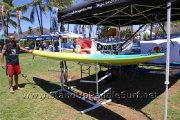 Mark Raaphorst with the Bullet
Mark Raaphorst with the Bullet
You can see in the pictures below the difference between the F-16 v2 and the Bullet. The F-16 is on the left side.
Here’s a video of Andrea Moller paddling on her Bullet 17’4″ sent to us by Mark Raaphorst:

(click thumbnail to launch video)
And some more pictures of the Bullet from a recent downwind run with the S.I.C. crew:
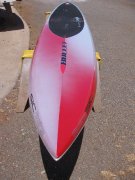
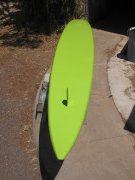
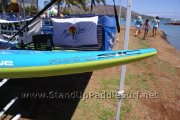
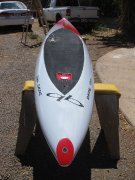
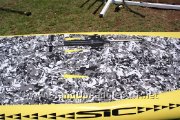
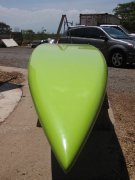
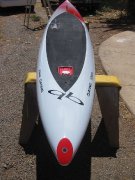
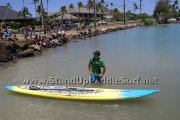
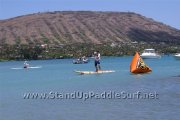
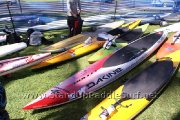
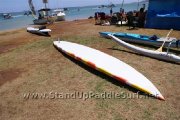
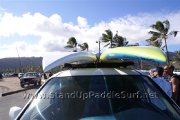
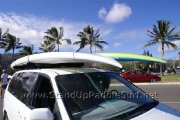
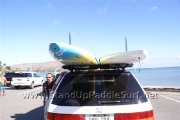
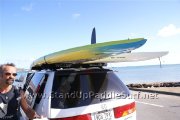
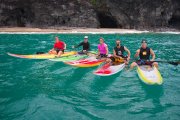
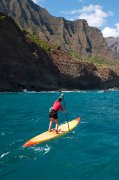
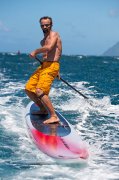
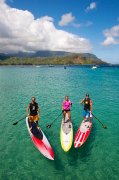























I just got a chance to try this board, the one with the green bottom in the pictures above. I tried it on Friday in just about the best conditions we get here on Oahu. Winds were 20 mph and the tide was great. The only thing that got me worried was the south shore swell that made the finish kinda hard.
The bumps were bigger and closer together than our normal Hawaii Kai run due to the wind. I found that the Bullet’s nose poked a bit more than the F-16 v2 which has much more nose rocker. It took more muscle to get it up to speed although once it gets momentum, it just keeps going. This board reminds me of my F-18, more than the F-16 v2 in the way it glides. I also had this weird feeling that I wasn’t going that fast but when I looked at my Garmin GPS watch, I was moving faster than I felt.
The Diamond Head portion of the run was really fast. It may have been the fastest I’ve ever done it on a SUP. It almost felt like an OC-1 where the Bullet just kept catching bumps and entering the next one on its own. That section was really good. My friend that I went with also said that part was the best portion of the run.
People are asking how the Bullet compares to the v2. I think in those conditions, the v2 would have been really good too. In fact, the high winds conditions are what make the v2 so fun. The v2 is more of a surfboard feeling ride and gets up to speed quicker. The v2 is also much more stable to balance on. The Bullet is easier to stand on than the F-18 but a bit more tippy vs the v2. I need to get more time in different conditions to get a better idea of which one is better for what.
I think Mark did a good job in the rudder placement and performance of the Bullet. It turns on a dime.
Evan,
Am curious how the Bullet stacks up to the Naish Glide 17′.
Thanks for running this site!
Jim – I haven’t tried the glide yet. I’ve ridden the bullet in 20 mph+ winds twice so far and I’ve been really pleased. The ride is quite a bit different than the F-16 v2. It takes more power to get it moving but once it starts moving it glides with little effort. The nose was poking quite a bit but I think if the wind was under 20 mph then that wouldn’t be as much of an issue. It’s similar to the glide of the F-18 but much more stable.
Evan thanks for all the helpful Info!! I will be getting mine this week can’t wait to try. See you in the water Aloha’s
Weston
Evan
Do you know why Mark has gone back to the circle steering system on the Bullet ? And why does he not use this on the F-16 V2 steering system ? It seems to me the circle steering and steel cables are more solid than the set up on the V2. I know he uses the circle steering on the F-14 as well as the F-18. It’s not like the V2 is cheap !!
Evan,
Thanks much for the input. You have probably been asked this already; but here goes. If you could have only one board, and the bulk of your paddling was doing Hawaii Kai runs, would you go with the v2 or the Bullet? Thanks ….
Jimmy – If I could only have one board between the V2 and Bullet and was only doing Hawaii Kai runs I personally would choose the V2. The V2 is more surfy, stable, easier to get up to speed, lighter, easier to transport and store. My style of paddling is least effort possible so I like the easy paddling feel of the V2. That said, the Bullet is a close second. The Bullet takes more muscle to get up to speed but once it starts moving, the following glide is better. It’s like a train, it takes more to get it moving and more to slow it down. I’ve been riding the V2 on windy days and having a blast and on lighter wind days it’s been between the Bullet and the Pueo OC-1.
Mark sent over a video by Bill Boyum in Maui with his team on the Bullet. Within 10 seconds of watching it was obvious to me how that Andrea Moller is much stronger than I am.
Evan, what if you were mainly paddling on flat water conditions like a lake? Trying to decide between a Bark 14′ Displacement, an F16 V2, and a Bullett. We do get a little wind and some boat chop, but its not like your downwinders by any means.
CaseyG – The Bullet and F16 V2 aren’t designed for flat water conditions. They are best with wind and bump. For flat water, if you’re considering SIC, the F-18, S-16 Standamaran, X-14 or a custom would be a better choice. The displacement nose on the Bark 14 is nice in flat water.